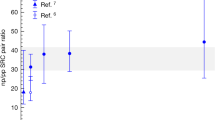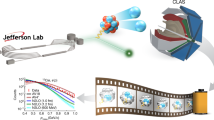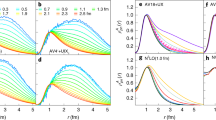Abstract
The atomic nucleus is made of protons and neutrons (nucleons), which are themselves composed of quarks and gluons. Understanding how the quark–gluon structure of a nucleon bound in an atomic nucleus is modified by the surrounding nucleons is an outstanding challenge. Although evidence for such modification—known as the EMC effect—was first observed over 35 years ago, there is still no generally accepted explanation for its cause1,2,3. Recent observations suggest that the EMC effect is related to close-proximity short-range correlated (SRC) nucleon pairs in nuclei4,5. Here we report simultaneous, high-precision measurements of the EMC effect and SRC abundances. We show that EMC data can be explained by a universal modification of the structure of nucleons in neutron–proton SRC pairs and present a data-driven extraction of the corresponding universal modification function. This implies that in heavier nuclei with many more neutrons than protons, each proton is more likely than each neutron to belong to an SRC pair and hence to have distorted quark structure. This universal modification function will be useful for determining the structure of the free neutron and thereby testing quantum chromodynamics symmetry-breaking mechanisms and may help to discriminate between nuclear physics effects and beyond-the-standard-model effects in neutrino experiments.
This is a preview of subscription content, access via your institution
Access options
Access Nature and 54 other Nature Portfolio journals
Get Nature+, our best-value online-access subscription
$29.99 / 30 days
cancel any time
Subscribe to this journal
Receive 51 print issues and online access
$199.00 per year
only $3.90 per issue
Buy this article
- Purchase on Springer Link
- Instant access to full article PDF
Prices may be subject to local taxes which are calculated during checkout




Similar content being viewed by others
Data availability
The raw data from this experiment are archived in Jefferson Laboratory’s mass storage silo.
References
Hen, O., Miller, G. A., Piasetzky, E. & Weinstein, L. B. Nucleon-nucleon correlations, short-lived excitations, and the quarks within. Rev. Mod. Phys. 89, 045002 (2017).
Norton, P. R. The EMC effect. Rep. Prog. Phys. 66, 1253–1297 (2003).
Frankfurt, L. & Strikman, M. Hard nuclear processes and microscopic nuclear structure. Phys. Rep. 160, 235–427 (1988).
Weinstein, L. B., Piasetzky, E., Higinbotham, D. W., Gomez, J., Hen, O. & Shneor, R. Short range correlations and the EMC effect. Phys. Rev. Lett. 106, 052301 (2011).
Hen, O., Piasetzky, E. & Weinstein, L. B. New data strengthen the connection between short range correlations and the EMC effect. Phys. Rev. C 85, 047301 (2012).
Geesaman, D., Saito, K. & Thomas, A. The nuclear EMC effect. Annu. Rev. Nucl. Part. Sci. 45, 337–390 (1995).
Malace, S., Gaskell, D., Higinbotham, D. W. & Cloet, I. The challenge of the EMC effect: existing data and future directions. Int. J. Mod. Phys. E 23, 1430013 (2014).
Aubert, J. et al. The ratio of the nucleon structure functions \({F}_{2}^{N}\) for iron and deuterium. Phys. Lett. B 123, 275–278 (1983).
Gomez, J. et al. Measurement of the A dependence of deep inelastic electron scattering. Phys. Rev. D 49, 4348–4372 (1994).
Seely, J. et al. New measurements of the European Muon Collaboration effect in very light nuclei. Phys. Rev. Lett. 103, 202301 (2009).
degli Atti. C. C. In-medium short-range dynamics of nucleons: recent theoretical and experimental advances. Phys. Rep. 590, 1–85 (2015).
Fomin, N. et al. New measurements of high-momentum nucleons and short-range structures in nuclei. Phys. Rev. Lett. 108, 092502 (2012).
Frankfurt, L. L., Strikman, M. I., Day, D. B. & Sargsyan, M. Evidence for short-range correlations from high Q 2 (e,e′) reactions. Phys. Rev. C 48, 2451–2461 (1993).
CLAS Collaboration. Observation of nuclear scaling in the A(e,e′) reaction at x B > 1. Phys. Rev. C 68, 014313 (2003).
CLAS Collaboration. Measurement of two- and three-nucleon short-range correlation probabilities in nuclei. Phys. Rev. Lett. 96, 082501 (2006).
Tang, A. et al. n–p short-range correlations from (p, 2p + n) measurements. Phys. Rev. Lett. 90, 042301 (2003).
Piasetzky, E., Sargsian, M., Frankfurt, L., Strikman, M. & Watson, J. W. Evidence for strong dominance of proton–neutron correlations in nuclei. Phys. Rev. Lett. 97, 162504 (2006).
Shneor, R. et al. Investigation of proton–proton short-range correlations via the 12C(e,e′pp) reaction. Phys. Rev. Lett 99, 072501 (2007).
Subedi, R. et al. Probing cold dense nuclear matter. Science 320, 1476–1478 (2008).
Korover, I. et al. Probing the repulsive core of the nucleon–nucleon interaction via the 4He(e,e′pN) triple-coincidence reaction. Phys. Rev. Lett. 113, 022501 (2014).
CLAS Collaboration. Momentum sharing in imbalanced Fermi systems. Science 346, 614–617 (2014).
CLAS Collaboration. Probing high-momentum protons and neutrons in neutron-rich nuclei. Nature 560, 617 (2018).
Mecking, B. A. et al. The CEBAF large acceptance spectrometer (CLAS). Nucl. Instrum. Meth. A 503, 513–553 (2003).
Hakobyan, H. et al. A double target system for precision measurements of nuclear medium effects. Nucl. Instrum. Meth. A 592, 218–223 (2008).
CLAS Collaboration. Measurement of the neutron F 2 structure function via spectator tagging with CLAS. Phys. Rev. Lett. 108, 142001 (2012); erratum 108, 199902 (2012).
Chen, J.-W., Detmold, W., Lynn, J. E. & Schwenk A. Short-range correlations and the EMC effect in effective field theory. Phys. Rev. Lett. 119, 262502 (2017).
Hen, O., Higinbotham, D. W., Miller, G. A., Piasetzky, E. & Weinstein, L. B. The EMC effect and high momentum nucleons in nuclei. Int. J. Mod. Phys. E 22, 1330017 (2013).
Arrington, J., Coester, F., Holt, R. J. & Lee, T. S. H. Neutron structure functions. J. Phys. G 36, 025005 (2009).
Hen, O. et al. In medium nucleon structure functions, SRC, and the EMC effect. Preprint at https://arxiv.org/abs/1409.1717 (2014).
Cloët, I. C., Bentz, W. & A. W. Thomas, A. W. Isovector EMC effect explains the NuTeV anomaly. Phys. Rev. Lett. 102, 252301 (2009).
Acknowledgements
We acknowledge the efforts of the staff of the Accelerator and Physics divisions at Jefferson Laboratory that made this experiment possible. The analysis presented here was carried out as part of the Jefferson Laboratory Hall B Data-Mining project, supported by the US Department of Energy (DOE). The research was also supported by the National Science Foundation, the Israel Science Foundation, the Chilean Comisión Nacional de Investigación Científica y Tecnológica, the French Centre National de la Recherche Scientifique and Commissariat a l’Energie Atomique, the French–American Cultural Exchange, the Italian Istituto Nazionale di Fisica Nucleare, the National Research Foundation of Korea and the UK Science and Technology Facilities Council. The research of M.S. was supported by the US DOE, Office of Science, Office of Nuclear Physics, under award number DE-FG02- 93ER40771. Jefferson Science Associates operates the Thomas Jefferson National Accelerator Facility for the DOE, Office of Science, Office of Nuclear Physics under contract DE-AC05-06OR23177.
Author information
Authors and Affiliations
Consortia
Contributions
CLAS was designed and constructed by the CLAS Collaboration and Jefferson Laboratory. Data acquisition, processing and calibration, Monte Carlo simulations of the detector and data analyses were performed by a large number of CLAS Collaboration members, who also discussed and approved the scientific results. The analysis presented here was performed by B.S. and A.S. with input from S.G., O.H., E. Piasetzky and L.B.W. and reviewed by the CLAS collaboration.
Corresponding author
Ethics declarations
Competing interests
The authors declare no competing interests.
Additional information
Publisher’s note: Springer Nature remains neutral with regard to jurisdictional claims in published maps and institutional affiliations.
Extended data figures and tables
Extended Data Fig. 1 models.
\({{\boldsymbol{F}}}_{2}^{{\boldsymbol{n}}}\,{\rm{/}}\,{{\boldsymbol{F}}}_{2}^{{\boldsymbol{p}}}\) Ratio of neutron to proton structure functions, \({F}_{2}^{n}\,{\rm{/}}\,{F}_{2}^{p}\), derived from the SRC-driven EMC model (blue band) used in the isoscalar corrections of refs 9 (‘SLAC’, red line) and 10 (‘JLab Hall C’, green line) and derived in the CTEQ-14 global fit, shown here for Q2 = 10 GeV2 (grey band). The large spread among the various models shows the uncertainty in \({F}_{2}^{n}\), a key ingredient in the isoscalar corrections previously applied to the EMC effect data.
Supplementary information
Supplementary Information
This file contains Supplementary Text and Data, which includes Supplementary Figures 1-4, Supplementary Tables 1-7 and additional references
Rights and permissions
About this article
Cite this article
The CLAS Collaboration. Modified structure of protons and neutrons in correlated pairs. Nature 566, 354–358 (2019). https://doi.org/10.1038/s41586-019-0925-9
Received:
Accepted:
Published:
Issue Date:
DOI: https://doi.org/10.1038/s41586-019-0925-9
This article is cited by
-
New extended method for ψ′ scaling function of inclusive electron scattering
Science China Physics, Mechanics & Astronomy (2023)
-
Revealing the short-range structure of the mirror nuclei 3H and 3He
Nature (2022)
-
Many-body factorization and position–momentum equivalence of nuclear short-range correlations
Nature Physics (2021)
-
Nucleon momentum distribution of 56Fe from the axially deformed relativistic mean-field model with nucleon-nucleon correlations
Science China Physics, Mechanics & Astronomy (2021)
-
Flavor-dependent radiative corrections in coherent elastic neutrino-nucleus scattering
Journal of High Energy Physics (2021)
Comments
By submitting a comment you agree to abide by our Terms and Community Guidelines. If you find something abusive or that does not comply with our terms or guidelines please flag it as inappropriate.



